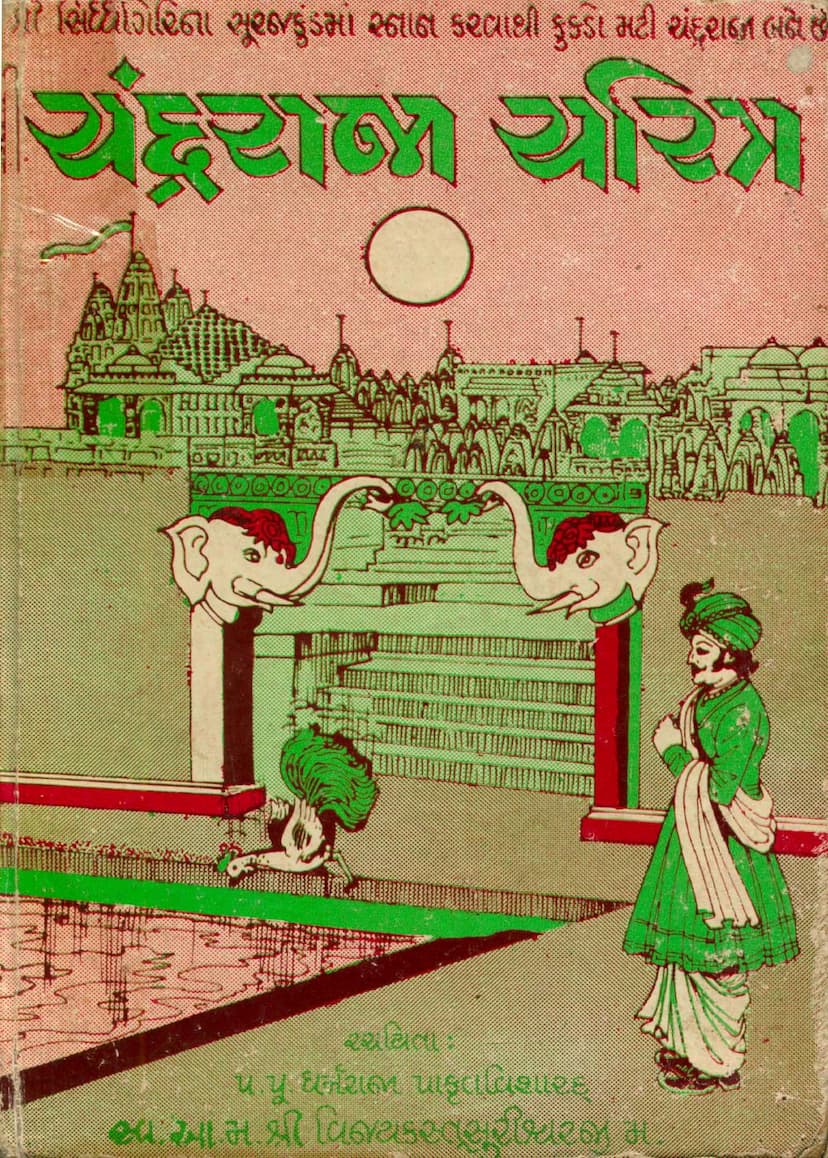Chandra Raja Charitra
Added to library: September 1, 2025

Summary
This comprehensive summary of the "Chandra Raja Charitra" is based on the provided Jain text.
Book Title: Chandra Raja Charitra (or Siri Chandraya Chariyam in Prakrit) Author: Acharya Kastursuri (original author), Pandit Ranchoddas Baraiya (translator) Publisher: Shri Nemi-Vigyan-Kastursuri Gyan Mandir Core Theme: The life and virtuous conduct of King Chandra, emphasizing chastity (Sheel), the power of good deeds (punya), and the spiritual significance of the Shatrunjay pilgrimage.
Summary of the Narrative:
The "Chandra Raja Charitra" is a Jain narrative that tells the story of King Chandra, a virtuous ruler whose life was marked by profound moral strength, devotion, and significant spiritual experiences. The text, originally in Prakrit, has been translated into Gujarati, making the story accessible to a wider audience.
Key Events and Themes:
-
The Curse and Transformation: The narrative begins with King Chandra, the son of King Veerse, and Queen Chandravati. Due to a curse from his stepmother Veermati, who used a magical ritual, King Chandra was transformed into a hen. This transformation highlights the destructive potential of negative emotions like jealousy and revenge, even when employed by family members.
-
The Role of Shatrunjay: The story emphasizes the transformative power of the holy pilgrimage site of Shatrunjay. It was the water from the Suryakund at Shatrunjay that miraculously restored King Chandra to his human form, curing him of his cursed state. This underscores the paramount importance of pilgrimage and devotion in Jainism for spiritual purification and overcoming adversity.
-
Chastity and Virtue: The narrative places a strong emphasis on the virtue of chastity (Sheel). King Chandra's adherence to his vows and his unwavering commitment to his principles, even in the face of great challenges and temptations, are central to his character. This virtue is portrayed as a source of his strength and eventual redemption.
-
The Power of Deeds (Punya): The story illustrates how past good deeds (punya) can lead to favorable outcomes, even amidst curses and hardships. King Chandra's good karma plays a significant role in his eventual liberation from the curse and his return to righteousness.
-
Adversity and Resilience: King Chandra faces numerous trials, including his transformation into a hen. The story showcases his resilience and unwavering faith, demonstrating how one can maintain their inner strength and virtue even when subjected to external hardships.
-
Spiritual Guidance and Redemption: The narrative often involves spiritual guidance from wise figures and the importance of adhering to Jain principles. The ultimate goal of King Chandra's journey, like that of all virtuous souls in Jain tradition, is spiritual liberation (Moksha).
-
The Translator's and Author's Intent: The translator, Pandit Kapoorchand Ranchoddas Baraiya, expresses the intention of making the story accessible for spiritual benefit, particularly for young minds, to guide them towards righteous living and the pursuit of right faith, knowledge, and conduct (SamyaG Darshan-Gyan-Charitra). The author, Acharya Kastursuri, is praised for his profound knowledge of Prakrit and his ability to create accessible literary works that enrich Jain literature.
Structure and Content (as indicated by the index):
The "Chandra Raja Charitra" is divided into four chapters (Uddesh). The index outlines the progression of the story:
- Chapter 1: Description of Jambudweep, King Veersen of Abhapurinagari, King Chandra's hunting incident leading to his separation and encounter with a yogi, protection of a maiden, marriage, birth of Chandrakumar, Veermati's schemes, her acquisition of supernatural powers, King Veerse's renunciation, and Chandrakumar's ascension to the throne. It also covers Veermati's manipulation and the role of Shatrunjay pilgrimage in restoring King Chandra.
- Chapter 2: Continues with Chandra Raja's journey, his encounter with King Simhal, the revelation of his true identity, and the intricacies of his relationships and political dealings. It includes the story of King Kanakdev, who suffers from leprosy, and the subsequent marriage arrangements.
- Chapter 3: Focuses on the unfolding of events, including Veermati's actions, the impact of her curses, and the continuing narrative of King Chandra's virtuous journey, often interspersed with moral teachings.
- Chapter 4: Details King Chandra's ultimate spiritual realization, his adherence to Jain principles, and the path to liberation, culminating in his attainment of Moksha. It also covers the stories of other characters and their spiritual paths.
In essence, the "Chandra Raja Charitra" serves as a moral and spiritual guide, illustrating the Jain path to liberation through virtuous living, devotion, and the understanding of karma and spiritual principles. The story is rich with narrative detail, highlighting the importance of chastity, faith, and the ultimate triumph of righteousness over adversity.